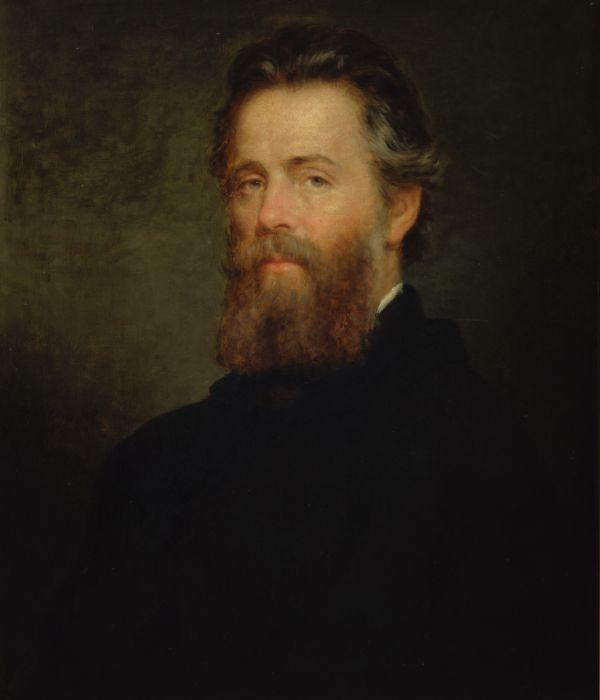Today's Birthday
Herman Melville1819–91, American author, born in New York City.
Considered one of the great American writers and a major figure in world literature.
Early Life and Works
Born into an impoverished family of distinguished Dutch and English colonial descent, Melville was 12 when his father died. He left school at 15, worked at a variety of jobs, and in 1839 signed on as a cabin boy on a ship bound for Liverpool, an experience reflected in his romance Redburn. In 1841–42 he spent 18 months on a whaler, but intolerable hardships on board caused him and a companion to escape from the ship at the Marquesas Islands. The two were captured by a tribe of cannibals, by whom they were well treated. After being rescued by an Australian whaler, Melville spent some time in Tahiti and other Pacific islands before shipping home in 1844.
The immediate results of his experiences were Typee: A Peep at Polynesian Life (1846), Omoo: A Narrative of Adventures in the South Seas (1847), as well as Redburn (1849), all fresh, exuberant, and immensely popular romances. In 1847, Melville married Elizabeth Shaw, the daughter of Lemuel Shaw, Chief Justice of Massachusetts. The popularity of his books brought him prosperity, business trips to Europe, and admission to literary circles in New York City. In 1850 he bought a farm near Pittsfield, Mass., and became friends with his neighbor Nathaniel Hawthorne. The allegorical implications evident in his romances Mardi: and a Voyage Thither (1849) and White-Jacket; or, The World in a Man-of-War (1850) reached full development in Melville's masterpiece, Moby-Dick; or, The Whale (1851).
Moby-Dick
The story of a deranged whaling captain's obsessive voyage to find and destroy the great white whale that had ripped off his leg, the novel is at once an exciting sea story, a sociological critique of various American class and racial prejudices, a repository of information about whales and whaling, and a philosophical inquiry into the nature of good and evil, of man and his fate. The novel is heavily symbolic, and many critical formulations have been made as to the meaning of its central symbol, the great white whale Moby-Dick himself. Moby-Dick is greatly enhanced by Melville's rhythmic, rhetorical prose style. Although it is now considered one of the greatest of all novels, Moby-Dick was misunderstood and ill-received in its time. Readers were confused by the book's symbolism, and they failed to grasp Melville's complex view of the world.
Later Works and Life
Like Moby-Dick, Pierre; or, The Ambiguities (1852), a psychological study of guilt and frustrated good, was disregarded by the public. Disheartened by debts, ill health, and the failure to win an audience, Melville became absorbed in mysticism. He was unable to accept the optimism of transcendentalism, for he was always able to see the cruel as well as the beautiful in nature. Although he searched for a faith that would satisfy his yearning for the Absolute, he never found one. Melville continued to produce important works in The Piazza Tales (1856), a collection which includes “Benito Cereno” and “Bartleby the Scrivener,” and The Confidence Man: His Masquerade (1857), a pessimistic satire on materialism.
Melville was forced to sell his farm, and in 1866 he secured a poorly paying position in New York City as a district inspector of customs, a job he held for 19 years. His late works include the volumes of poetry Battle-Pieces and Aspects of the War (1866) and John Marr and Other Sailors (1888); the long poem Clarel (1876); and the posthumously published novella Billy Budd, Foretopman (1924), the tragedy of an innocent. Melville died in poverty and obscurity. Although neglected for many years, he was rediscovered around 1920 and has been enthusiastically studied by critics and scholars ever since. Many of his unpublished works were issued posthumously, notably The Apple Tree Table (1922), a collection of magazine sketches; Journal of a Visit to London and the Continent (1948); and Journal of a Visit to Europe and the Levant (1955).
Bibliography:
See his letters (ed. by M. R. Davis and W. H. Gilman, 1960); biographies by Leon Howard (1981) and Geoffrey Wolff (1987); studies by Michael Rogin (1983), Neil Tolchin (1988), and W. Dimock (1989).
Who2. Copyright © 1998-2006 by Who2?, LLC. All rights reserved.
Also Born on August 01
- Claudius IRoman Emperor (10)
- Jean Baptiste Lamarcknaturalist (1744)
- William Clarkexplorer (1770)
- Francis Scott Keyauthor of national anthem (1779)
- Maria Mitchellastronomer (1818)
- Yves Saint Laurentfashion designer (1936)
- Jerry Garciamusician (1942)
Who Shares Your Birthday?
The Day You Were Born
The Year You Were Born











